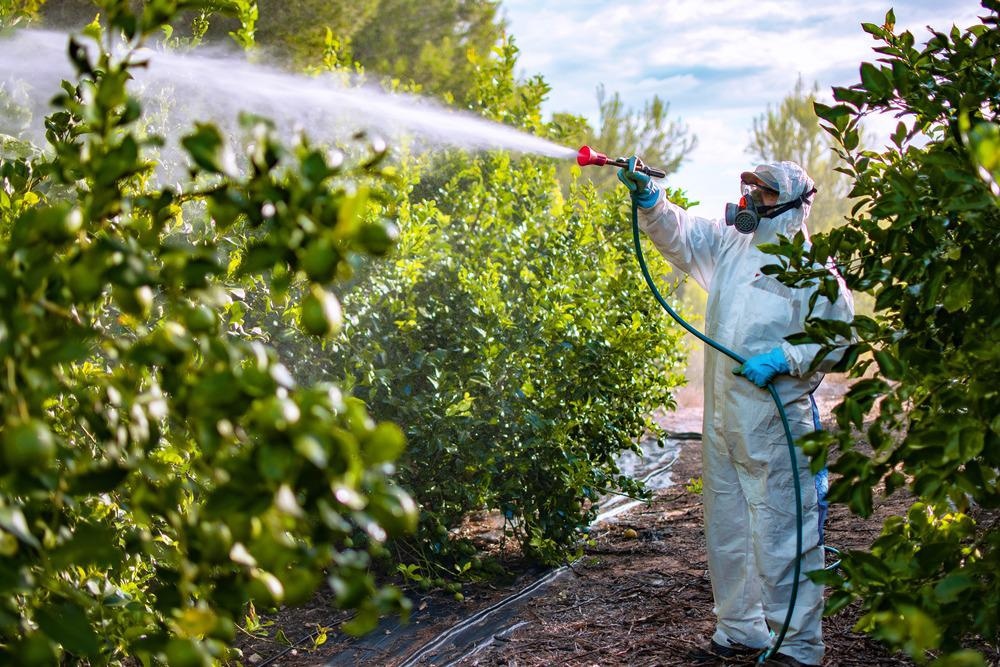Nanotechnology research offers a realistic and efficient method for reducing pesticide waste and enhancing pesticide consumption. A new publication in the journal ACS Agricultural Science & Technology discusses the development of chlorpyrifos-loaded silica nanomaterials enhanced with polydopamine (Cpf-MSNs@PDA) for intelligent pest management.

Study: An Alkali-Triggered Polydopamine Modified Mesoporous Silica Nanopesticide for Smart Delivery of Chlorpyrifos with Low Loss. Image Credit: David Moreno Hernandez/Shutterstock.com
The release of chlorpyrifos from the hybrid composite was alkali- and heat-dependent, ensuring the effective constituent's continuous and consistent efficacy over an extended period. The creation of an intelligent nanoparticle for the management of a specific plant diseases generates new ideas for organic farming.
Importance of Pesticides
Pesticides are critical for reducing and managing plant diseases, bugs, and weeds, which are necessary for agricultural production, repairing around 30% of worldwide crop damage. However, more than 90% of conventional pesticides infiltrate the ecosystem during the deposition process, resulting in environmental damage.
Presently, it is believed that developing a controlled-release pesticide technology would efficiently decrease pesticide wastage and increase pesticide consumption. With the advancement of nanomaterials and their widespread use in crop production, several novel pesticide compositions have been created, including nano caplets, nanoliposomes, and nanogels.
Various nanoparticles, including graphene oxide, charcoal, elastomer, and kaolin minerals, have been employed as pesticide carriers so far.
Mesoporous Silica Nanoparticles (MSNs) as Pesticide Carriers
Among these alternate substrates, mesoporous silica nanoparticles (MSNs) are recognized as attractive transport nanomaterials for drug delivery applications owing to their high effective porous structure volume, tunable pore size, and good cytocompatibility. MSNs are considered to be reasonably safe for crops and can be employed as pesticide transporters to ensure effective pesticide administration, with no inhibition zone or lesion found in the treated plants during trials.
Additionally, the conveniently synthesized surface morphology of MSNs enables the incorporation of adaptable substances or polymeric materials, enabling the development of a nanopesticide delivery mechanism that is responsive to external stimuli (such as pH, illumination, and heat) and thus enables the controlled release of pesticide elements.
Polydopamine (PDA): pH-Responsive Gatekeeper Molecule
To achieve the precise reaction of a nanopesticide to environmental stimuli, the nanocomposite's surface layer is often altered with reactive gatekeeper molecules. Due to its excellent biological properties, high adhesion, and high photocatalytic effectiveness, polydopamine (PDA), a substance derived from mussels, has garnered significant interest. PDA's superior film-forming capacity enables it to be uniformly deposited on the exterior of a wide variety of materials for general applications. Additionally, several studies have shown that PDA can be employed as a pH-responsive gatekeeper molecule to regulate drug delivery systems.
Development of an Intelligent Nanopesticide Composite
In this study, the researchers developed a smart nanopesticides compound based on a PDA-modified mesoporous silica nanocomposite (MSN) structure that helps pesticide particles to be released in response to an alkaline stimulus.
Chlorpyrifos (Cpf), a wide-spectrum organophosphate pesticide with dermal contact and gastro toxicity, was chosen as the prototype pesticide due to its widespread usage in farming to control pests. The release rate of Cpf was thoroughly investigated in the presence of pH and other biogenic triggers. Cpf-foliar MSNs@PDA's adherence, rainfall-runoff tolerance, and pesticide effectiveness were also investigated to determine its durability.
Research Conclusion and Prospect
In conclusion, Cpf-MSNs@PDA, an alkali-triggered nanoscale pesticide combination, was developed in this work. The microporous morphology on the interface of the MSNs was restricted due to the containment of PDA, which limits the extraction efficiency of Cpf into the external environment.
To produce the alkaline-triggered discharge of Cpf-MSNs@PDA, PDA works as a pH-responsive barrier molecule. This novel composite was discovered to have outstanding foliar adherence and great rainfall erosion resistance in simulated testing, indicating that it can significantly prevent pesticide losses due to leaf slippage and rainfall runoff. The presence and degradability of pesticides in the midgut were established by inspection of the gastrointestinal tissue of M. separata, and the probable mechanism of Cpf-MSNs@PDA was established.
This research suggests a viable method for reducing pesticide wastage and contamination in the ecosystem. However, simulated results may not provide accurate physical results. Therefore, field studies should be conducted to improve the efficacy of nanopesticide compounds in the future.
Reference
Kan, Q. et al. (2022). An Alkali-Triggered Polydopamine Modified Mesoporous Silica Nanopesticide for Smart Delivery of Chlorpyrifos with Low Loss. ACS Agricultural Science & Technology. Available at: https://pubs.acs.org/doi/10.1021/acsagscitech.1c00269.
Disclaimer: The views expressed here are those of the author expressed in their private capacity and do not necessarily represent the views of AZoM.com Limited T/A AZoNetwork the owner and operator of this website. This disclaimer forms part of the Terms and conditions of use of this website.